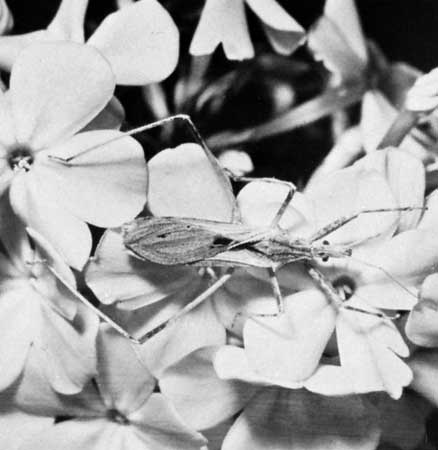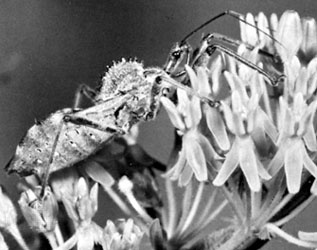assassin bug
insect
 any of about 4,000 species of insects in the true bug order, Heteroptera, that are characterized by a thin, necklike structure connecting the narrow head to the body. They range in size from 10 to 25 mm (0.4 to 1 inch). An assassin bug uses its short, three-segmented beak to suck the body fluids from its victims. A characteristic of this family is that the beak is curved and lies in a groove between the front legs. Although assassin bugs are generally black or dark brown, some species are brightly coloured. Most members of the family live outdoors and prey on other insects. However, some suck blood from vertebrates, including humans, and transmit diseases.
any of about 4,000 species of insects in the true bug order, Heteroptera, that are characterized by a thin, necklike structure connecting the narrow head to the body. They range in size from 10 to 25 mm (0.4 to 1 inch). An assassin bug uses its short, three-segmented beak to suck the body fluids from its victims. A characteristic of this family is that the beak is curved and lies in a groove between the front legs. Although assassin bugs are generally black or dark brown, some species are brightly coloured. Most members of the family live outdoors and prey on other insects. However, some suck blood from vertebrates, including humans, and transmit diseases.An important member of this family is the kissing bug (Melanolestes picipes). Its common name derives from the fact that it usually bites humans on the face around the mouth. This black-coloured insect is about 12 mm (0.5 inch) long and is usually found under stones and bark. It also feeds on other insects.
The masked hunter (Reduvius personatus) is also known as the masked bedbug hunter, or kissing bug. During the immature stages the body, legs, and antennae are covered with sticky hairs that catch pieces of lint and dust, camouflaging the insect as a ball of dust. The brownish black adult, about 15 or 20 mm (0.6 or 0.75 inch) long, is commonly found in houses preying on insects, such as bedbugs and flies. It will also feed on humans and has a painful bite. Though originally a central European species, the masked hunter has spread throughout the southern parts of North America since its accidental introduction into the port of New York.
One of the best-known assassin bugs is the cone-nose bug (Triatoma), also known as the kissing bug, big bedbug, or Mexican bedbug. The adult is black with six red spots on each side of the abdomen and is about 25 mm long. The species T. sanguisuga is usually found in a bed, where it feeds on human blood. Its painful, toxic bite may cause faintness, swelling, and vomiting. The South American species T. megista, also known as the barber beetle, is the carrier of Chagas' disease and a trypanosome protozoan disease. Chagas' disease can also be transmitted by a related South American pest, Rhodnius prolixus. This bloodsucking assassin bug has been much used in insect physiology research. T. rubrofasciata, found living in the debris on hut floors in southern Asia, may transmit kala-azar.
Pristhesancus papuensis is known as the bee killer. This bug waits on flowers to capture and suck the body fluids from honeybees and other insects that frequent flowers.
 The wheel bug (Arilus cristatus) is recognized by the notched crest on the top of the thorax. The adult is gray and quite large (about 25 mm); the nymph is red with black marks. Wheel bugs occur in North America, are predaceous on other insects, and have a painful bite if handled. The venomous saliva is pumped into a victim through one channel in the wheel bug's beak. The digested body fluids of the prey are then pumped into the wheel bug's stomach through another channel in the beak.
The wheel bug (Arilus cristatus) is recognized by the notched crest on the top of the thorax. The adult is gray and quite large (about 25 mm); the nymph is red with black marks. Wheel bugs occur in North America, are predaceous on other insects, and have a painful bite if handled. The venomous saliva is pumped into a victim through one channel in the wheel bug's beak. The digested body fluids of the prey are then pumped into the wheel bug's stomach through another channel in the beak.The thread-legged bug (Emesa brevipennis) is about 33 mm (1.3 inches) long and is usually found on trees or in old buildings. It has long, threadlike middle and hindlegs, while the shorter, thicker front legs are modified into viselike grasping organs.
An Asian member of the family, Ptilocerus ochraceus, has a most unusual method of capturing prey. Tufts of red hair on its abdomen attract certain ants, which lick a glandular secretion from the hairs and become paralyzed. The assassin bug then pierces the ant with its beak and sucks out the body fluids.
The large assassin bug Platymerus has an effective means of protection. Its powerful salivary pump enables it to “spit” saliva as far as 30 cm (12 inches). It has an accurate aim, and the saliva can cause blindness in humans.
Some authorities also include the predatory ambush bug (Phymatidae) in the assassin bug family.
- Civil Guard
- Civilian Conservation Corps
- Civilis, Gaius Julius
- Civilista
- Civilization
- civil law
- Civil List
- Civil Rights Act
- civil rights movement
- civil service
- civil union
- Civita Castellana
- Civitanova Marche
- civitas
- Civitavecchia
- Cixi
- Cixous, Hélène
- Cizhou kiln
- Cizin
- Ciénaga
- C.J. Koch
- C.K. Ogden
- C.K. Stead
- C.K. Williams
- Clackmannanshire